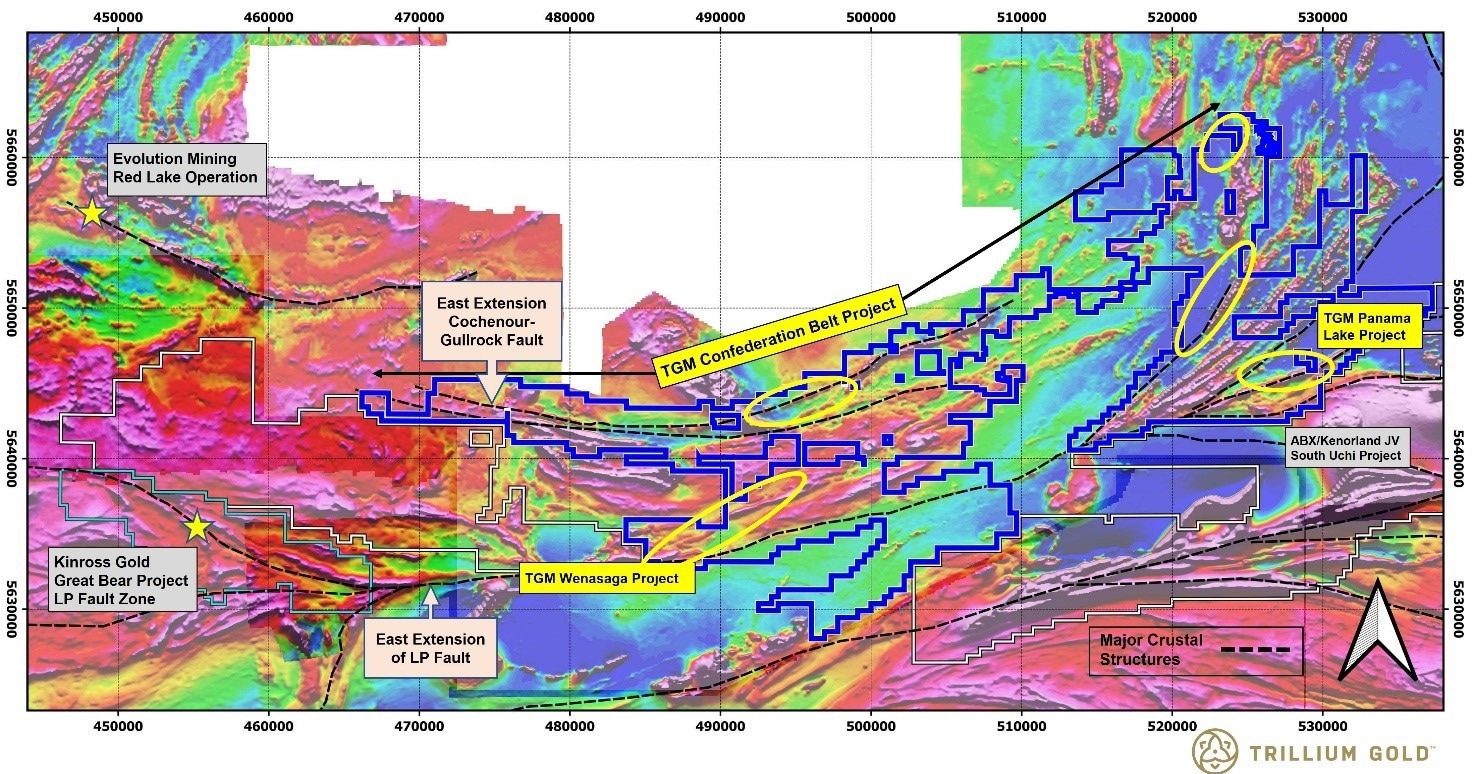Reviewed by Alex SmithAug 10 2022
Trillium Gold Mines Inc. has provided an update on the current activities at the greater Confederation belt projects of Trillium Gold Mines Inc. at Red Lake, Ontario.
 Trillium’s main contiguous land package (in blue) in the Confederation greenstone belt. Major fault structures shown for context; yellow ellipses represent areas from which historical core is being prioritized for sampling. Also shown are the Barrick Gold JV properties (in white) and Kinross Gold’s Great Bear Project (in teal). Base aeromagnetics from the Ontario Geological Survey Red Lake Super Grid. Image Credit: Trillium Gold Mines
Trillium’s main contiguous land package (in blue) in the Confederation greenstone belt. Major fault structures shown for context; yellow ellipses represent areas from which historical core is being prioritized for sampling. Also shown are the Barrick Gold JV properties (in white) and Kinross Gold’s Great Bear Project (in teal). Base aeromagnetics from the Ontario Geological Survey Red Lake Super Grid. Image Credit: Trillium Gold Mines
These initiatives provide substantial leverage to the geological trends that have helped Red Lake earn its position as a premier mining jurisdiction, including the LP Fault Zone of the “Dixie” discovery [Kinross Gold] and Red Lake Operations [Evolution Mining].
The Red Lake mining area team from Trillium has been attempting to identify, locate, and collect any historical core that is still present on or adjacent to the site. In the past, a sizable amount of drilling was either selectively sampled or tested only for base metals.
This core is now being categorized and given retrieval priority so that it can be re-logged and sampled for gold.
Other drill core caches are known through assessment files; there are now 16 historical caches known, though not all are accessible; new ones are discovered every week. Personnel from Trillium will keep looking for and removing the core from those as well.
Trillium offers an excellent, affordable opportunity to generate great results without the need for more drilling, particularly in the holes that fall inside the boundaries of the targets that Trillium has identified.
This is exactly what happened at Kinross’ Great Bear Project with a historical drill hole from 2007 when the core was found and analyzed, leading to the realization that the LP Fault Zone was substantially larger than was previously thought.
A significant amount of historical drilling has already taken place which Trillium’s geological team has diligently collated and synthesized over recent months towards developing an extensive drill target database.
William Paterson, Vice President, Exploration, Trillium Gold
He added, “Worth noting is the opinion of one very prominent geological expert in Red Lake that the next gold deposit to be discovered in the Confederation belt has, in all likelihood, already been drilled, having gone unrecognized or unsampled. Hence the importance of identifying and sampling historical drilling.”
Trillium’s geology team has been collecting more soil and litho-geochemical samples in addition to logging and assaying prior drill holes.
Programs for prospecting and mapping have been developed throughout the Confederation Project area to target fresh gold discoveries and to prioritize known and emerging target regions based on the findings of the 2021 fieldwork.
The Confederation Project’s internal property mapping by earlier explorers revealed complicated structural and lithological geometries that were all appropriate for the deposition of gold.
The LP Fault structure, which marks a significant separation between felsic and mafic volcanic rocks on the southern boundary, and the Red Lake Mine-related Cochenour-Gullrock structure, which forms the northern perimeter, are the two main structures that encircle the Confederation Project.
The Confederation and Panama Lake Projects of Trillium are located on more than 40 km of the eastward extension of the LP Fault, which is a deep crustal fault.
The North Confederation Project of Trillium contains a second deep crustal fault that mirrors the LP Fault at Kinross’ Great Bear Project.
The Ministry of Northern Development, Mines, Natural Resources, and Forestry (MNDMNRF) has divided the drill permitting procedure into six applications to accommodate the project’s expansive territory and give flexibility.
The company will be able to start a drilling program across the project area on targets that will have been thoroughly investigated, given a high priority, and determined to be drill ready once these Early Exploration drilling licenses are in place.
The recently purchased Wenasaga Property, which is geographically connected to a dilation zone found on the LP Fault’s eastward expansion, will be one of the main areas of attention.
This deep-rooted structure could have provided a conduit for gold-bearing fluids where the dilation zone established the conditions for this gold to be deposited, whether chemically or rheologically, through widespread alteration. Initial work has already started at this part of the property.
The Panama Lake Property, another recently acquired area, features two extremely promising gold-mineralized trends that have not yet been extensively explored. Other compilation work has also revealed additional structural and lithological dislocations.
The main buildings that cross the property seem to be splays from, or are the eastern extension of, the LP Fault structure. On the site, there are several gold and VMS-style mineralization occurrences, and a field program has been created to further explore and assess the lateral continuity of these mineralized trends.
The historical core from the Panama Lake Property has been located, and the field evaluation of Maxtech Ventures’ 2020 drilling (1,667 m in 4 holes) has taken place. 174 samples from the core that had never been sampled before have been chosen and sent for gold assay.
Selected sampling will also be carried out on the Benton Resources drill core from 2019 (1,430 m in 9 holes), which has already been located.
The Confederation belt projects have provided Trillium with a once-in-a-lifetime opportunity to look for other LP Fault analogs, additional gold mineralization akin to that found in Red Lake, and key minerals along a structure that is far bigger and just as promising as the Great Bear Project.